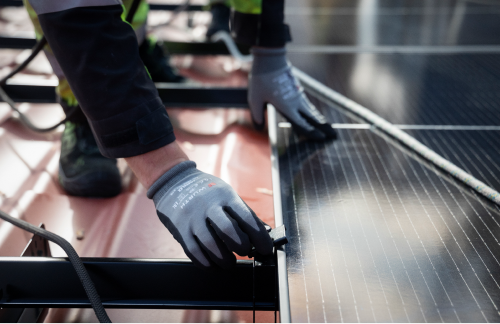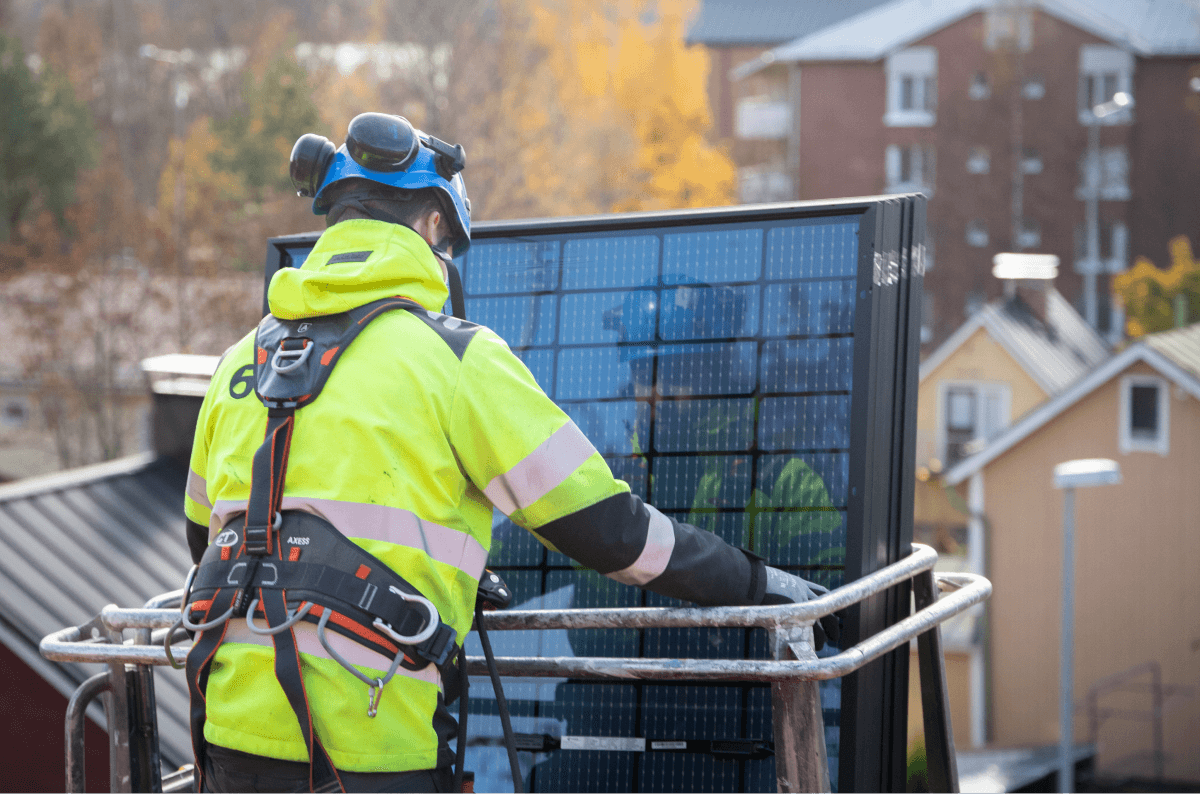Solar panels
What if part of your electricity came from your own roof? With solar panels, you can produce up to 30% of it yourself.
What if part of your electricity came from your own roof? With solar panels, you can produce up to 30% of it yourself.

Aurinkopaneelit maksavat itsensä takaisin 8-15 vuodessa, ja niiden käyttöikä on 30-40 vuotta, mikä tarkoittaa yli kahden vuosikymmenen puhdasta tuottoa.
Auringolla tuotettu energia on 100% uusiutuvaa, ja oman tuotannon ansiosta olet vähemmän riippuvainen energiamarkkinoiden vaihteluista. Ne nostavat myös kiinteistösi arvoa.

We use only high-quality solar panels that are built to perform. Our panels are efficient 410–435 Wp models, and our power output guarantees are among the longest in the industry.
All components in our systems represent top-tier quality and are carefully selected to suit the demanding Finnish climate.

With over 160,000 panels installed, our expert team ensures every installation meets the highest industry standards.
.jpg?width=2000&height=1333&name=Lumme_Kuustonen_mokki_Kuva_PihlaLiukkonenKontrastia-62%20(1).jpg)
With Lumme Energia’s Säästömalli payment plan, you pay for solar panels interest-free and fee-free
Choose a monthly payment plan of 24, 36, 48, or 60 months – and take advantage of the savings your solar panels generate to help cover the installments.
The installation cost will be invoiced separately.
Curious about solar power? Our site assessment gives you the clarity you need.
We’ll create a customized production simulation based on your property's energy consumption data, analyzing expected output on both monthly and annual levels.
Together, we’ll identify the solar panel model that best fits your needs and budget.
We’ll calculate the optimal number of panels for your specific situation.
Finally, we’ll explore how to maximize the benefits of your solar system and estimate the payback period for a tailored solution.
If you’re unable to use all the electricity you generate, the excess – known as surplus electricity – is automatically transferred to the local grid. This surplus energy shouldn’t go to waste, so we recommend contacting our customer service to arrange a surplus electricity sales agreement with Lumme Energia.
Lumme Energia purchases surplus electricity from customers at the hourly market price for Finland on the Nord Pool power exchange.
No brokerage fee is charged from private customers.
Business customers are charged a brokerage fee of €0.0024/kWh (VAT 0%).
Monthly fee: €0/month (VAT 0%).
To qualify, you must purchase electricity from Lumme Energia for the same consumption metering point that your production is connected to. The value of the surplus electricity is credited on the same electricity bill as your consumption.
We send 12 bills per year for both your production and consumption sites. If this is not possible, a separate credit invoice will be used. Any compensation for surplus electricity is reduced by the charges related to the sale of electricity during the billing period. If the fees exceed the value of the surplus electricity, the difference must be paid to Lumme Energia.
All surplus energy credits are returned directly to your bank account. When the contract ends, the value of any sold electricity is credited in the final invoice, which will be issued six weeks after the agreement ends.
Please note: If you move, your fixed-term electricity contract will be terminated unless you sign a new agreement for your new address.
In half-cut solar panels, the solar cells are divided in half, allowing for more efficient energy production. A half-cut panel can also generate electricity even when partially shaded.
The self-consumption rate describes how much of the electricity produced by a solar power system is used directly at the property where the electricity is generated.
The higher the self-consumption rate, the greater the savings for you. This is because when you use solar electricity on-site, you save not only on your energy bill, but also on energy-based transmission fees and electricity tax.
When you sell excess electricity to the grid, you receive compensation based on the Nordic spot price—that is, the hourly market price weighted by energy on the Nordic electricity market. In practice, this corresponds roughly to the energy fee charged by your electricity supplier.
An inverter converts the direct current (DC) generated by solar panels into electricity that is compatible with the power grid.
A solar power system consists of solar panels and an inverter. Solar panels generate direct current (DC) electricity from sunlight, and the inverter converts it into alternating current (AC) electricity suitable for the grid.
When solar energy is converted into alternating current for the grid, the voltage often exceeds 230 volts. The inverter ensures that the voltage does not rise above the allowed limit during the conversion process.
Tier 1 is an international and independent classification granted only to solar panel manufacturers that have the financial capability to support a 20–30 year product warranty.
The metering method has a significant impact on the self-consumption rate. In three-phase connections, electricity distribution companies typically use instantaneous per-phase metering.
With per-phase metering, the meter measures—at any given moment—the amount of electricity purchased from or fed into the grid on each individual phase.
For example, if during one hour you purchase 2 kWh of electricity on one phase and export 1 kWh on another phase, you will pay the full price for the 2 kWh you bought, and receive compensation only for the 1 kWh you exported.
The abbreviation Wp stands for watt-peak, which refers to the peak power output of a solar panel under standard test conditions.
Watt-peak indicates the maximum power the panel can produce when tested at a temperature of +25 °C and under solar irradiance of 1,000 W/m² (1,000 watts per square meter).
If you are unable to use all the electricity you generate, the excess is called surplus electricity, which is transferred to the local electricity grid.
Surplus electricity refers to the portion of electricity that is fed into the grid rather than being consumed at the property where it was generated—for example, from solar panels. The local electricity network company’s meters measure the amount of electricity exported to the grid on an hourly basis.
The technical lifespan of solar panels can exceed 30 years, which is why they typically come with a power output warranty of 25–30 years.
There are different terms for power output warranties, but the most common is that the panels will produce at least 80% of their nominal output throughout a 25-year period, as guaranteed by the manufacturer.
With external production monitoring, various production data from the inverter can be read, depending on the specific solar power system.
Most commonly, solar production monitoring is used to track the system’s real-time output. It also allows reviewing past solar panel production based on a selected time period.
Production monitoring cannot be used to control the system — it only enables reading production data, for example via a computer or mobile device.
When you purchase a solar power system for your home, you can take advantage of a household tax credit for the installation work.
Säästömalli is Lumme Energia’s fee-free and interest-free installment payment option. You can use the Säästömalli to cover the cost of solar panels.
The labor portion is billed separately, but you may be eligible for a household tax credit on that part.
You can choose the number of interest-free monthly payments: 24, 36, 48, or 60 months.
This allows you to use the savings generated by your solar panels to help pay off the system over time.
Yes, you can conveniently purchase your solar power system from us with financing.
You can use our interest-free and fee-free Säästömalli installment plan to pay for the system itself.
The installation work can be paid in full by invoice, or you can use other financing options to cover the labor portion.